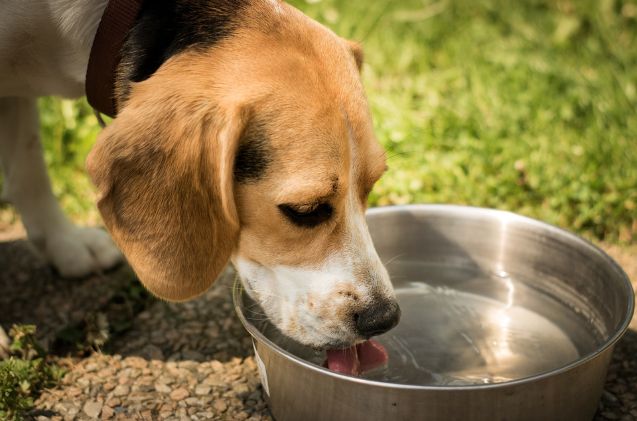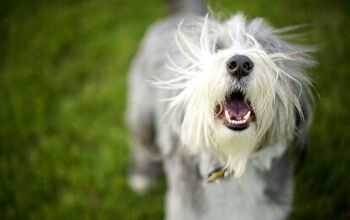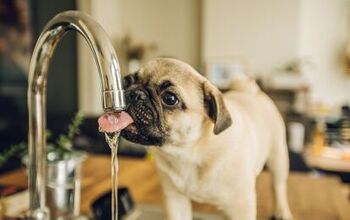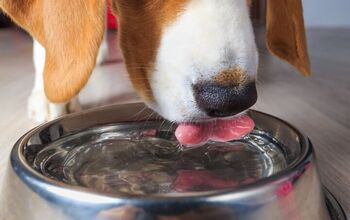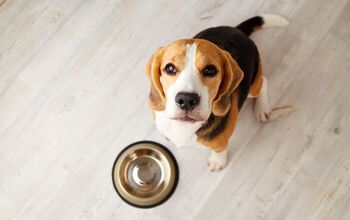Why Is My Dog Drinking So Much Water?

Drinking fresh water regularly is an essential part of a healthy lifestyle. But many dog parents may wonder: How much water is too much? When should you be concerned? The answer is not always as easy as black and white. Some dogs naturally drink a lot of water, while an increase in drinking for others could indicate a health problem. The first step is identifying why your dog is drinking so much water.
How Much Water Should a Dog Drink?
Before you can identify whether your dog drinks too much water, you must determine how much water they should consume daily. A healthy adult dog should drink, on average, 1 ounce of water per 1 pound of body weight.
This means a 35 lb dog like our youngest boy Lucifer should drink 35 fluid ounces of water or 4.375 cups. A toy breed weighing 10 lbs would drink an average of 10 fluid ounces or 1 ¼ cups. A large breed weighing 100 lbs should drink approximately 100 fluid ounces or 12 ½ cups.
Of course, this is an average. Young puppies will need more water than a full-grown adult, as do pregnant or nursing dogs. If you live in a hot climate or have a very active lifestyle, this may also require more water to keep your dog safely hydrated. Finally, consider the fluids your dog may get from their food. If your dog is fed a diet of canned food, they are already getting hydration with their meals and require less water than a dog who is exclusively kibble fed.
12 Reasons Your Dog is Drinking So Much Water
If you notice that your dog is consuming significantly more water than they should be, based on the above calculation, it may indicate an underlying medical condition or a behavioral problem that needs to be addressed. Contact your veterinarian to share your concerns and make an appointment for the testing necessary to rule out these potential causes.
Side Effects of Medication
Is your dog currently taking medication or supplements for any reason? Many medications can cause excessive thirst or dry mouth, causing them to drink more and urinate more frequently.
High Sodium Food or Treats
Commercially available dog foods are formulated with sodium levels in mind, but the same can’t be said if your dog has been enjoying a few table scraps or special treats. Just as we get thirsty when eating overly salty foods, so does your dog. Pay careful attention to what your dog is being fed, not only by you but also by other family members.
Dehydration
Your dog may be dehydrated for several reasons, including gastrointestinal problems like diarrhea and vomiting. They may also be suffering from loss of hydration due to excessive urination. Dehydration can be serious and even fatal if not addressed. Pay careful attention to your dog’s fluid intake when they are feeling ill.
Diabetes
One of the most common warning signs of diabetes is excessive thirst and urination. This is caused by your body working overtime to accommodate the abnormally high glucose level. As the body excretes the excess glucose in the urine, it takes fluids from the body with it.
Kidney Damage
When the kidney fails, the body produces excess urine. This means your dog is losing hydration faster than they can replace with the recommended water intake. Kidney damage may result from an infection, toxins in the body, or chronic kidney disease.
Liver Disease
Your dog’s liver affects many normal bodily functions, including hormone production, fat metabolism, and blood detoxification. When the liver fails to keep up with these functions, it can result in excessive drinking and urination.
Cushing’s Disease/Cushing’s Syndrome
If your dog suffers from Cushing’s Disease, their body produces too much cortisol leading to a hormone imbalance. One of the common side effects of high cortisol levels in the body is higher than normal thirst and urination.
Infection
One of the body's natural responses to an infection is to flush out the unwanted virus or bacteria. Many different types of infections could be behind your dog’s increased thirst. Urinary Tract Infections often result in excess thirst, as does Pyometra, a uterine infection common in unspayed female dogs.
Fever
When dogs suffer from a fever or elevated body temperature, they often pant excessively to cool off. This causes them to lose fluids faster than they can replenish without drinking more. Other signs that your dog is suffering from a fever include cherry-red gums and stringy, rope-like saliva.
Cancer
Some forms of cancer can also cause excessive thirst and urination. This includes cancer of the liver, kidneys, adrenal gland, pituitary gland, or thyroid gland. While we never recommend jumping to the conclusion that your dog has cancer, it can be an early warning sign.
Psychogenic Polydipsia
All the other causes up to this point were physical conditions, but psychogenic polydipsia is a behavioral condition that causes a dog to continue drinking even when they are not physically thirsty. This may be triggered by anxiety, stress, or boredom. If you have ruled out all the above medical causes, you may need to consult a canine behaviorist. Watch for other signs of anxiety, stress, or boredom, including licking their paws, pacing, whining, barking, or hiding.
Dry Air
There is also a chance that your dog’s increased water intake directly results from your home environment. When the heat is running in the winter, many homes will experience dry air. This can lead to increased thirst. Other signs your air is too dry include allergy or asthma flair-ups, irritated sinuses, unexplained nose bleeds, and increased static electricity. You can address this problem by running a humidifier in the rooms where you and your dog spend most of your time.
How Do I Monitor My Dog’s Water Consumption?
Dog parents concerned about how much water their dog is drinking but aren’t sure if it is more than the recommended amount should monitor and track their dog’s water consumption over 24-48 hours. To do this, fill your dog’s water dish to a predetermined level each time, allowing you to measure how much water has been removed accurately. If you have multiple pets, separate the dog from the others during this time. Record how much water is missing from the dish each time you refill it and provide this information to your veterinarian during your appointment.

Britt Kascjak is a proud pet mom, sharing her heart (and her home) with her “pack” which includes her husband John, their 2 dogs – Indiana and Lucifer – and their 2 cats – Pippen and Jinx. She has been active in the animal rescue community for over 15 years, volunteering, fostering and advocating for organizations across Canada and the US. In her free time, she enjoys traveling around the country camping, hiking, and canoeing with her pets.
More by Britt



